Experimental Study on Bond Behavior of Glass Textile Mesh in Earth-Based Matrix
Abstract
:1. Introduction
2. Experimental Program
2.1. Materials Properties
2.2. Specimens
2.3. Test Set-Up
3. Experimental Results and Discussion
4. Prediction Model
5. Conclusions
- (1)
- The research found three different failure modes, respectively, pulling out, textile rupture and compound mode with pulling out and textile rupture. The development length was main factors affecting the different failure mode. The specimens with 100 mm and 200 mm development length all appeared pulling out and compound mode, but more specimens with 200 mm occurred compound mode. Especially, when the development length reached 300 mm, all of specimens exhibited textile rupture. In addition, the mesh spacing size and matrix thickness also had affected on failure mode to a certain extent.
- (2)
- The research factors affected the load-carrying capacities to varying degrees. The 200 mm and 300 mm development length specimens had an obvious improvement in the average peak force by 31.7% and 40.5% compared with 100 mm development length. The 20 mm mesh spacing size had the reduction in the average peak force by 5.72% compared to 10 mm mesh spacing size due to the reduction in the number of the textile along the weft direction while the value had an increase by 9.73% from 10 mm to 16 mm the matrix thickness due to the increase of the matrix strength.
- (3)
- The force versus displacement curves in the ascending section converted from the original linear to a nonlinear relationship due to micro-cracks gradually developing along the matrix/textile interface. In the descending section, the curves exhibited showed three different shapes according to different failure mode: a continuous softening trend (pulling out), a steep downward step (compound mode) and steep drop (textile rupture).
- (4)
- Theoretical curves based on the tri-linear shear bond-slip law simulated the characteristic of load softening in ascending section and precisely predicted the peak force, even though there was some deviation in descending section, proving the feasibility of the law applied to earth-based matrix. Moreover, the proposed theory based on fracture energy concept estimated effective bond length of glass textile mesh in the earth-based matrix was 300 mm at least.
Author Contributions
Funding
Institutional Review Board Statement
Informed Consent Statement
Data Availability Statement
Conflicts of Interest
References
- Bui, T.-T.; Bui, Q.-B.; Limam, A.; Maximilien, S. Failure of rammed earth walls: From observations to quantifications. Constr. Build. Mater. 2014, 51, 295–302. [Google Scholar] [CrossRef] [Green Version]
- Liu, K.; Wang, M.; Wang, Y. Seismic retrofitting of rural rammed earth buildings using externally bonded fibers. Constr. Build. Mater. 2015, 100, 91–101. [Google Scholar] [CrossRef]
- Wang, Y.; Liang, J.; Zhang, X.; Zhang, Y.; Gao, Y. Review of earthen structure in China. China Civ. Eng. J. 2015, 48, 98–107. [Google Scholar] [CrossRef]
- Wang, Y.; Zhong, J.; Shi, Y.; Quan, D.; Yue, X. Review of overseas research on raw-soil structure. China Civ. Eng. J. 2015, 48, 81–87. [Google Scholar] [CrossRef]
- Cao, N.; Zhang, Y. The problems and development directions of raw earth architecture. Sichuan Build. Mater. 2020, 46, 43–44. [Google Scholar]
- Correia, M.; Carlos, G. Local Seismic Culture in Portugal; Argumentum: Lisbon, Portugal, 2015. [Google Scholar]
- Meybodian, H.; Eslami, A.; Morshed, R. Sustainable lateral strengthening of traditional adobe walls using natural reinforcements. Constr. Build. Mater. 2020, 260, 119892. [Google Scholar] [CrossRef]
- Figueiredo, A.; Varum, H.; Costa, A.; Silveira, D.; Oliveira, C. Seismic retrofitting solution of an adobe masonry wall. Mater. Struct. 2013, 46, 203–219. [Google Scholar] [CrossRef] [Green Version]
- Hračov, S.; Pospíšil, S.; Garofano, A.; Urushadze, S. In-plane cyclic behaviour of unfired clay and earth brick walls in both unstrengthened and strengthened conditions. Mater. Struct. 2015, 49, 3293–3308. [Google Scholar] [CrossRef]
- Saleh, S.; Yunus, N.Z.M.; Ahmad, K.; Ali, N. Improving the strength of weak soil using polyurethane grouts: A review. Constr. Build. Mater. 2019, 202, 738–752. [Google Scholar] [CrossRef]
- Chen, W.; Zhang, Y.; Zhang, J.; Dai, P. Consolidation effect of composite materials on earthen sites. Constr. Build. Mater. 2018, 187, 730–737. [Google Scholar] [CrossRef]
- Li, C.; Wu, J.; Zhang, J.; Tong, C. Experimental study on seismic performance of precast concrete frame with replaceable energy-dissipating connectors. Eng. Struct. 2021, 231, 111719. [Google Scholar] [CrossRef]
- Huang, H.; Li, M.; Yuan, Y.; Bai, H. Theoretical analysis on the lateral drift of precast concrete frame with replaceable artificial controllable plastic hinges. J. Build. Eng. 2022, 62, 105386. [Google Scholar] [CrossRef]
- ACI committee 549. In Guide to Design and Construction of Externally Bonded Fabric-Reinforced Cementitious Matrix (FRCM) Systems for Repair and Strengthening Concrete and Masonry Structures; ACI 549.4R-13; ACI: Farmington hills, MI, USA, 2013.
- Koutas, L.N.; Tetta, Z.; Bournas, D.A.; Triantafillou, T.C. Strengthening of Concrete Structures with Textile Reinforced Mortars: State-of-the-Art Review. J. Compos. Constr. 2019, 23, 03118001. [Google Scholar] [CrossRef]
- Ai, S.; Yin, S.; Xu, S. A review on development of research and application of textile reinforced concrete. China Civ. Eng. J. 2015, 48, 27–40. [Google Scholar] [CrossRef]
- Cassese, P.; Fenu, L.; Asprone, D.; Occhiuzzi, A.; Parisi, F. In-Plane Behavior of Adobe Masonry Wallets Strengthened through Inorganic Matrix-Grid Composites. Key Eng. Mater. 2022, 916, 328–334. [Google Scholar] [CrossRef]
- Cassese, P.; Balestrieri, C.; Fenu, L.; Asprone, D.; Parisi, F. In-plane shear behaviour of adobe masonry wallets strengthened with textile reinforced mortar. Constr. Build. Mater. 2021, 306, 124832. [Google Scholar] [CrossRef]
- Allahvirdizadeh, R.; Oliveira, D.V.; Silva, R.A. In-Plane Seismic Performance of Plain and TRM-Strengthened Rammed Earth Components. In Proceedings of the IABSE Symposium: Towards a Resilient Built Environment Risk and Asset Management, Guimarães, Portugal, 27–29 March 2019; pp. 924–931. [Google Scholar] [CrossRef]
- Sadeghi, N.H.; Oliveira, D.V.; Silva, R.A.; Mendes, N.; Correia, M.; Azizi-Bondarabadi, H. Experimental characterization of adobe vaults strengthened with a TRM-based compatible composite. Constr. Build. Mater. 2021, 271, 121568. [Google Scholar] [CrossRef]
- Widder, L. Earth eco-building: Textile-reinforced earth block construction. Energy Procedia 2017, 122, 757–762. [Google Scholar] [CrossRef]
- Sueki, S.; Soranakom, C.; Mobasher, B.; Peled, A. Pullout-Slip Response of Fabrics Embedded in a Cement Paste Matrix. J. Mater. Civ. Eng. 2007, 19, 718–727. [Google Scholar] [CrossRef]
- Portal, N.W.; Perez, I.F.; Thrane, L.N.; Lundgren, K. Pull-out of textile reinforcement in concrete. Constr. Build. Mater. 2014, 71, 63–71. [Google Scholar] [CrossRef]
- Liu, S.; Rawat, P.; Chen, Z.; Guo, S.; Shi, C.; Zhu, D. Pullout behaviors of single yarn and textile in cement matrix at elevated temperatures with varying loading speeds. Compos. Part B Eng. 2020, 199, 108251. [Google Scholar] [CrossRef]
- Peled, A.; Bentur, A.; Yankelevsky, D. Effects of Woven Fabric Geometry on the Bonding Performance of Cementitious Composites. Adv. Cem. Based Mater. 1998, 7, 20–27. [Google Scholar] [CrossRef]
- Chudoba, R.; Konrad, M.; Schleser, M.; Meskouris, K.; Reisgen, U. Parametric study of tensile response of TRC specimens reinforced with epoxy-penetrated multi-filament yarns. In Proceedings of the 4th Colloquium on Textile Reinforced Structure (CTRS4); Technische Universität Dresden: Dresden, Germany, 2009; pp. 87–98. [Google Scholar]
- Carozzi, F.G.; Colombi, P.; Fava, G.; Poggi, C. A cohesive interface crack model for the matrix-textile debonding in FRCM composites. Compos. Struct. 2016, 143, 230–241. [Google Scholar] [CrossRef]
- Peled, A.; Sueki, S.; Mobasher, B. Bonding in fabric-cement systems: Effects of fabrication methods. Cem. Concr. Res. 2006, 36, 1661–1671. [Google Scholar] [CrossRef]
- Zhu, M.; Zhu, J.-H.; Ueda, T.; Su, M.; Xing, F. A method for evaluating the bond behavior and anchorage length of embedded carbon yarn in the cementitious matrix. Constr. Build. Mater. 2020, 255, 119067. [Google Scholar] [CrossRef]
- D’Ambrisi, A.; Feo, L.; Focacci, F. Experimental analysis on bond between PBO-FRCM strengthening materials and concrete. Compos. Part B Eng. 2013, 44, 524–532. [Google Scholar] [CrossRef]
- Qasem, A.; Sallam, Y.S.; Eldien, H.H.; Ahangarn, B.H. Bond-slip behavior between ultra-high-performance concrete and carbon fiber reinforced polymer bars using a pull-out test and numerical modelling. Constr. Build. Mater. 2020, 260, 119857. [Google Scholar] [CrossRef]
- Khabaz, A. Experimental and Numerical Investigation of Single Fiber Pull-Out Tests of Steel Macro-Fiber and Glass Micro-Fiber in a Cementitious Matrix. J. Test. Evaluation 2021, 50, 20200658. [Google Scholar] [CrossRef]
- Romanazzi, A.; Oliveira, D.V.; Silva, R.A. Experimental Investigation on the Bond Behavior of a Compatible TRM-based Solution for Rammed Earth Heritage. Int. J. Arch. Herit. 2019, 13, 1042–1060. [Google Scholar] [CrossRef]
- Romanazzi, A.; Oliveira, D.; Silva, R. An analytical bond stress-slip model for a TRM composite compatible with rammed earth. Constr. Build. Mater. 2021, 310, 125228. [Google Scholar] [CrossRef]
- Rathod, B.; Reddy, V. Bond Strength of Coir Fibers in Cement-Stabilized Rammed Earth Matrix. J. Mater. Civ. Eng. 2021, 33, 04021293. [Google Scholar] [CrossRef]
- Lepakshi, R.; Reddy, V. Bond strength of rebars in cement stabilised rammed earth. Constr. Build. Mater. 2020, 255, 119405. [Google Scholar] [CrossRef]
- Raavi, D.; Tripura, D. Predicting the effect of weathering and corrosion on the bond properties of bamboo- and steel-reinforced cement-stabilized rammed earth blocks. Adv. Struct. Eng. 2021, 24, 136943322110262. [Google Scholar] [CrossRef]
- Tripura, D.; Sharma, P. Bond behaviour of bamboo splints in cement-stabilised rammed earth blocks. Int. J. Sustain. Eng. 2013, 7, 24–33. [Google Scholar] [CrossRef]
- Luo, Y.; Zhong, H.; Ding, N.; Ni, P. Bond–Slip Mechanism of Rammed Earth-Timber Joints in Chinese Hakka Tulou Buildings. J. Struct. Eng. 2021, 147, 04021037. [Google Scholar] [CrossRef]
- Kong, L. Experimental Study on Modification of Building Wall Materials in Chongqing Area. Ph.D. Thesis, Southwest University, Chongqing, China, 2018. [Google Scholar]
- Zhou, S.; Yuan, S.; Yang, X. Comparison of consolidation effectiveness of acrylic non-aqueous dispersion and other anti-weathering consolidation for earthen architectures and monuments. Sci. Conserv. Archaeol. 2003, 2, 40–48. [Google Scholar] [CrossRef]
- Oliveira, D.V.; Silva, R.A.; Barroso, C.; Lourenço, P.B. Characterization of a Compatible Low Cost Strengthening Solution Based on the TRM Technique for Rammed Earth. Key Eng. Mater. 2017, 747, 150–157. [Google Scholar] [CrossRef]
- Cai, F. Study on Mechanical Properties of the Soil Material with Chemical Reinforcement. Ph.D. Thesis, Dalian Jiaotong University, Dalian, China, 2017. [Google Scholar] [CrossRef]
- Liu, J.; Shi, B.; Gu, K.; Shen, Z.-T.; Lu, Y. Laboratory study on soil modified by polyurethane sand-fixing agents. J. Disaster Prev. Mitig. Eng. 2013, 33, 29–34. [Google Scholar] [CrossRef]
- ASTM C109/C109M-20a; Standard Test Method for Compressive Strength of Hydraulic Cement Mortars (Using 2-in. or [50-mm] Cube Specimens). ASTM International: West Conshohocken, PA, USA, 2020.
- Zhou, H. The Research on Mechanical Properties of Glass Fiber Bundles and the Bond Properties of Glass Fiber Textile Reinforced Concrete. Ph.D. Thesis, Hunan University, Changsha, China, 2018. [Google Scholar]
- GB/T 3362-2005; Test Methods for Tensile Properties of Carbon Fiber Multifilament. China Building Materials Federation: Beijing, China, 2005.
- Banholzer, B. Bond of a strand in a cementitious matrix. Mater. Struct. 2006, 39, 1015–1028. [Google Scholar] [CrossRef]
- De Felice, G.; Aiello, M.A.; Caggegi, C.; Ceroni, F.; De Santis, S.; Garbin, E.; Gattesco, N.; Hojdys, H.; Krajewski, P.; Kwiecień, A.; et al. Recommendation of RILEM Technical Committee 250-CSM: Test method for Textile Reinforced Mortar to substrate bond characterization. Mater. Struct. 2018, 51, 95. [Google Scholar] [CrossRef]
- Jiang, J.; Jiang, C.; Li, B.; Feng, P. Bond behavior of basalt textile meshes in ultra-high ductility cementitious composites. Compos. Part B Eng. 2019, 174, 107022. [Google Scholar] [CrossRef]
- Zhang, X. Study on Uniaxial Tensile Properties of Textile Reinforced Cement-Based Composites. Ph.D. Thesis, Hebei University of Technology, Tianjin, China, 2017. [Google Scholar]
- Li, H. Study on Key Parameters and Anchorage Mechanism of Pull-out and Tensile Performance of C-FRCM Composites[D]; Shenzhen University: Shenzhen, China, 2020. [Google Scholar] [CrossRef]
- Xu, S.; Li, H. The calculational analysis of pullout phenomena textile reinforced concrete. J. Railw. Sci. Eng. 2005, 3, 15–21. [Google Scholar] [CrossRef]
- Colombi, P.; D’Antino, T. Analytical assessment of the stress-transfer mechanism in FRCM composites. Compos. Struct. 2019, 220, 961–970. [Google Scholar] [CrossRef]
- D’Ambrisi, A.; Feo, L.; Focacci, F. Bond-slip relations for PBO-FRCM materials externally bonded to concrete. Compos. Part B Eng. 2012, 43, 2938–2949. [Google Scholar] [CrossRef]
- Sanginabadi, K.; Mostofinejad, D. Effect of aggregate content on the CFRP-concrete effective bond length: An experimental and analytical study. Compos. Struct. 2021, 269, 114044. [Google Scholar] [CrossRef]
- Mostofinejad, D.; Arefian, B. Generic assessment of effective bond length of FRP-concrete joint based on the initiation of debonding: Experimental and analytical investigation. Compos. Struct. 2021, 277, 114625. [Google Scholar] [CrossRef]
- Tian, W.; Liu, X.; Zhang, L. Study on the adhesion properties of fiber braided mesh reinforced cement matrix composites. J. Agric. Univ. Hebei 2018, 41, 128–134. [Google Scholar] [CrossRef]
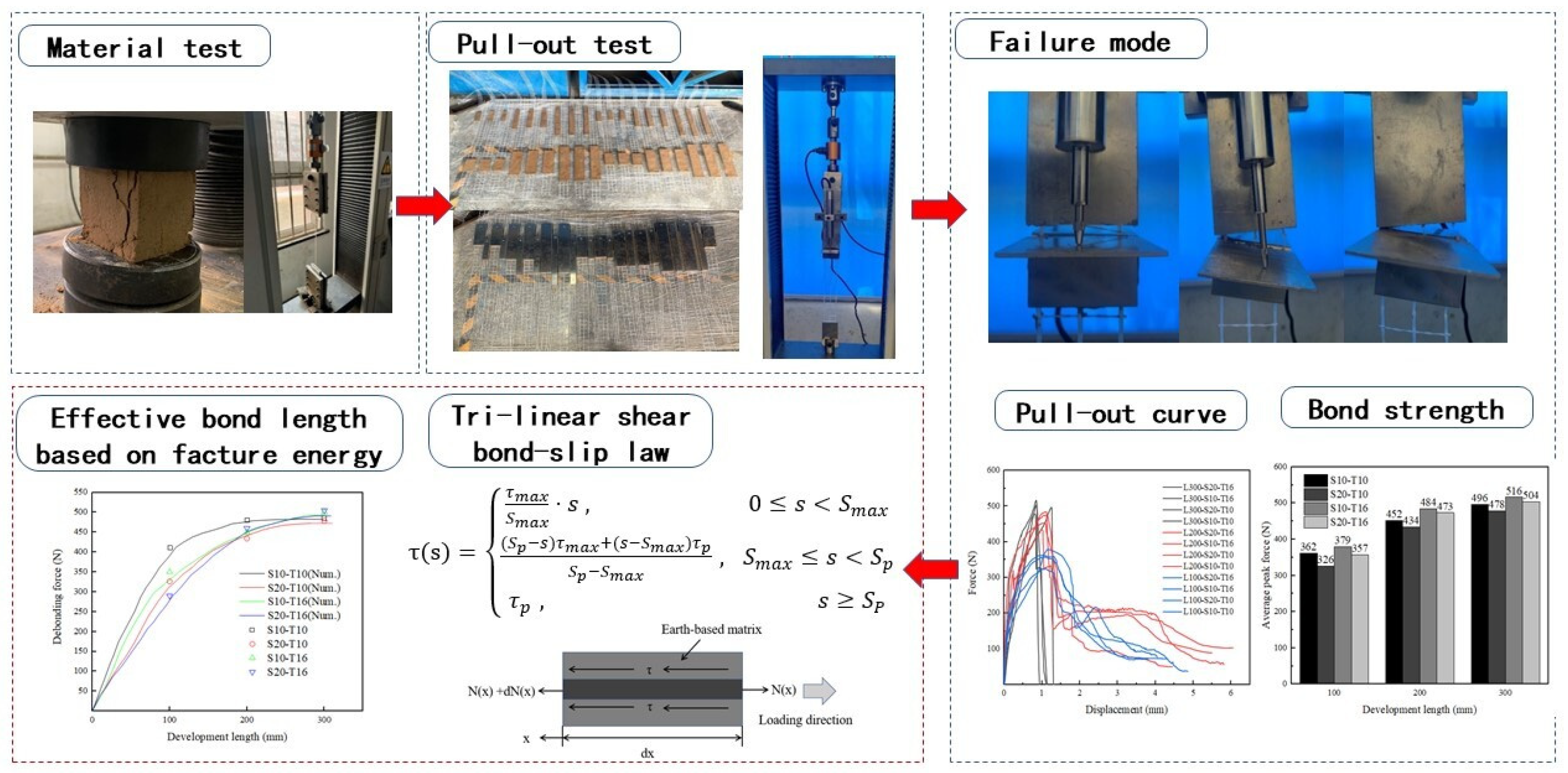

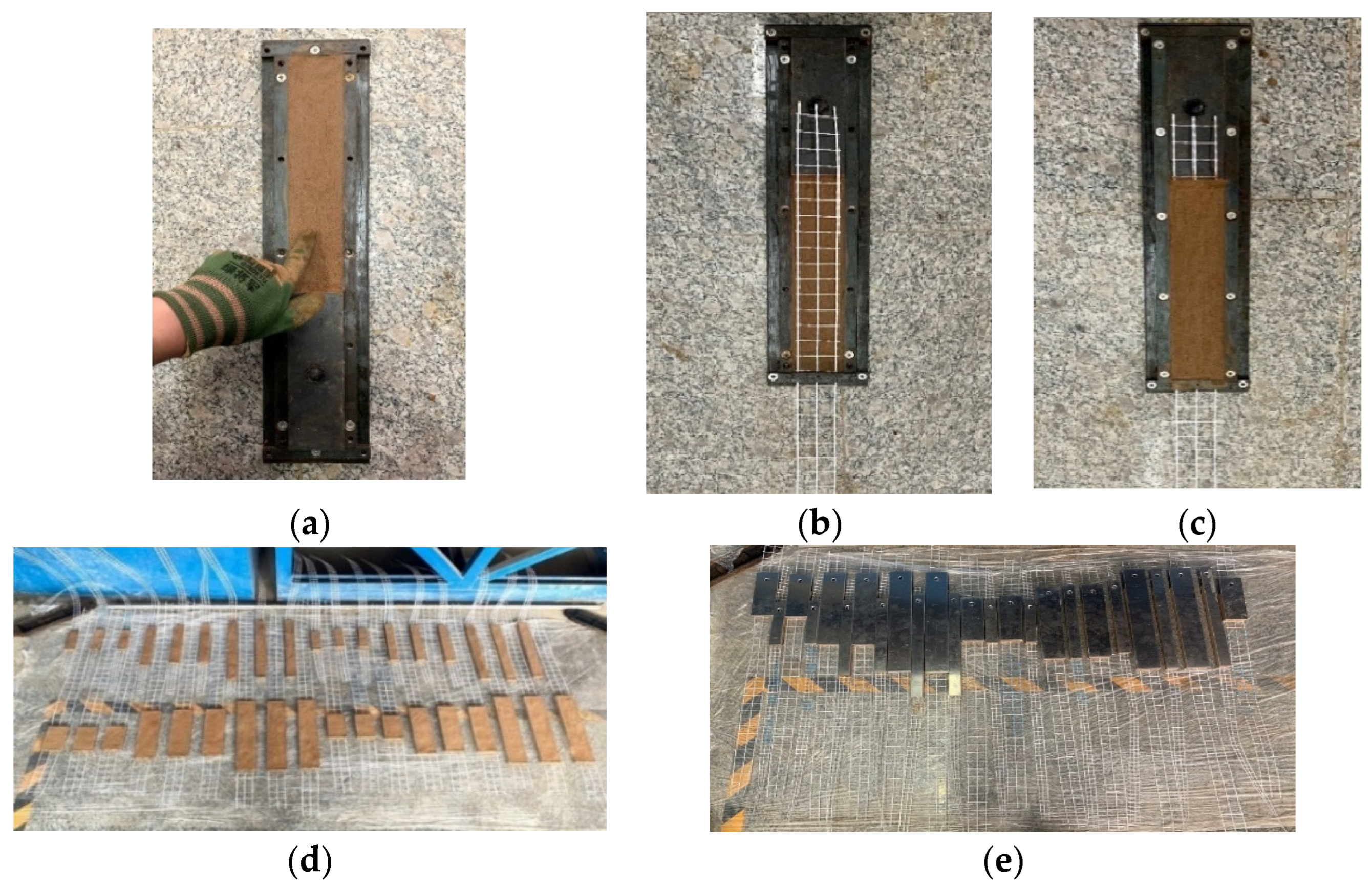

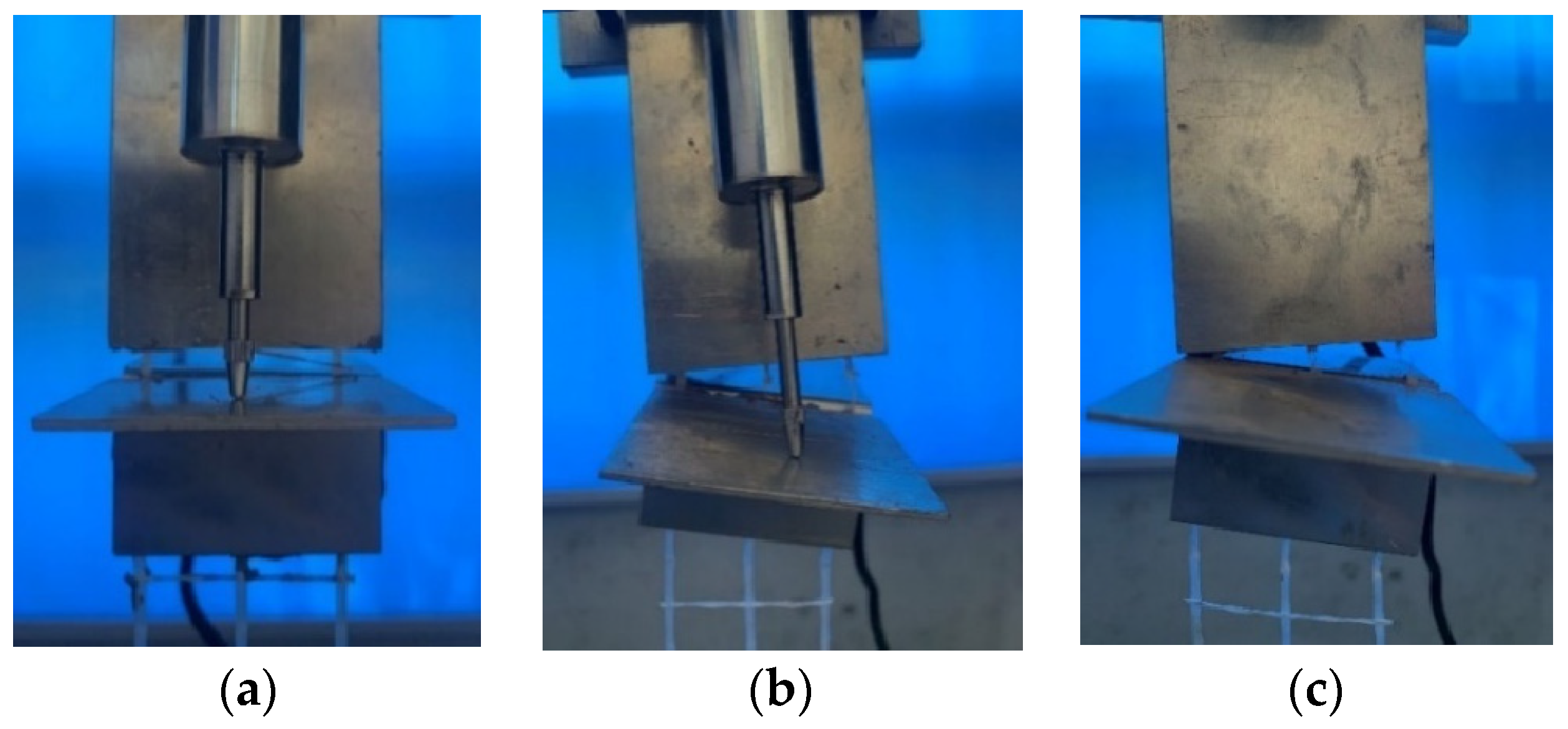
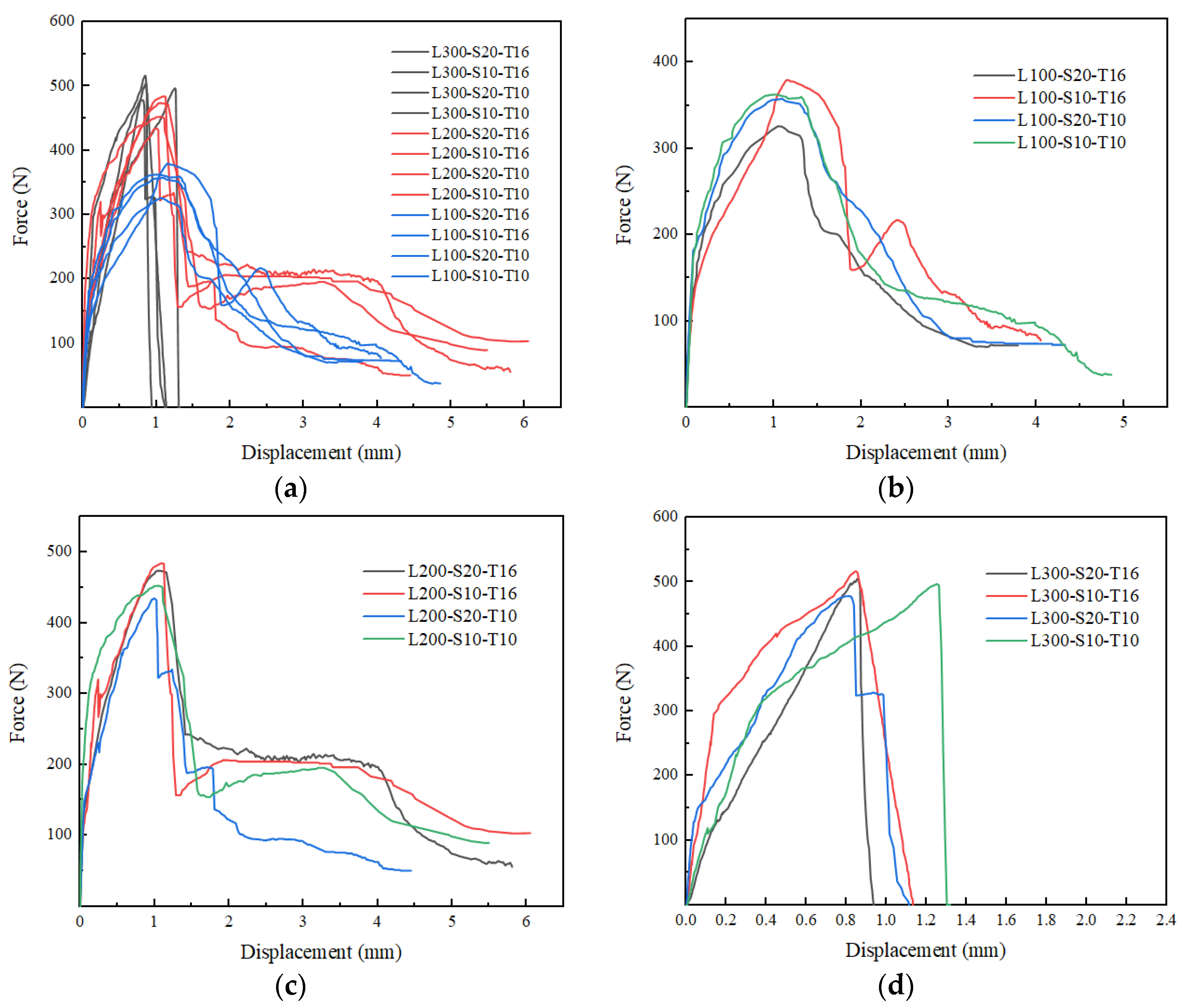
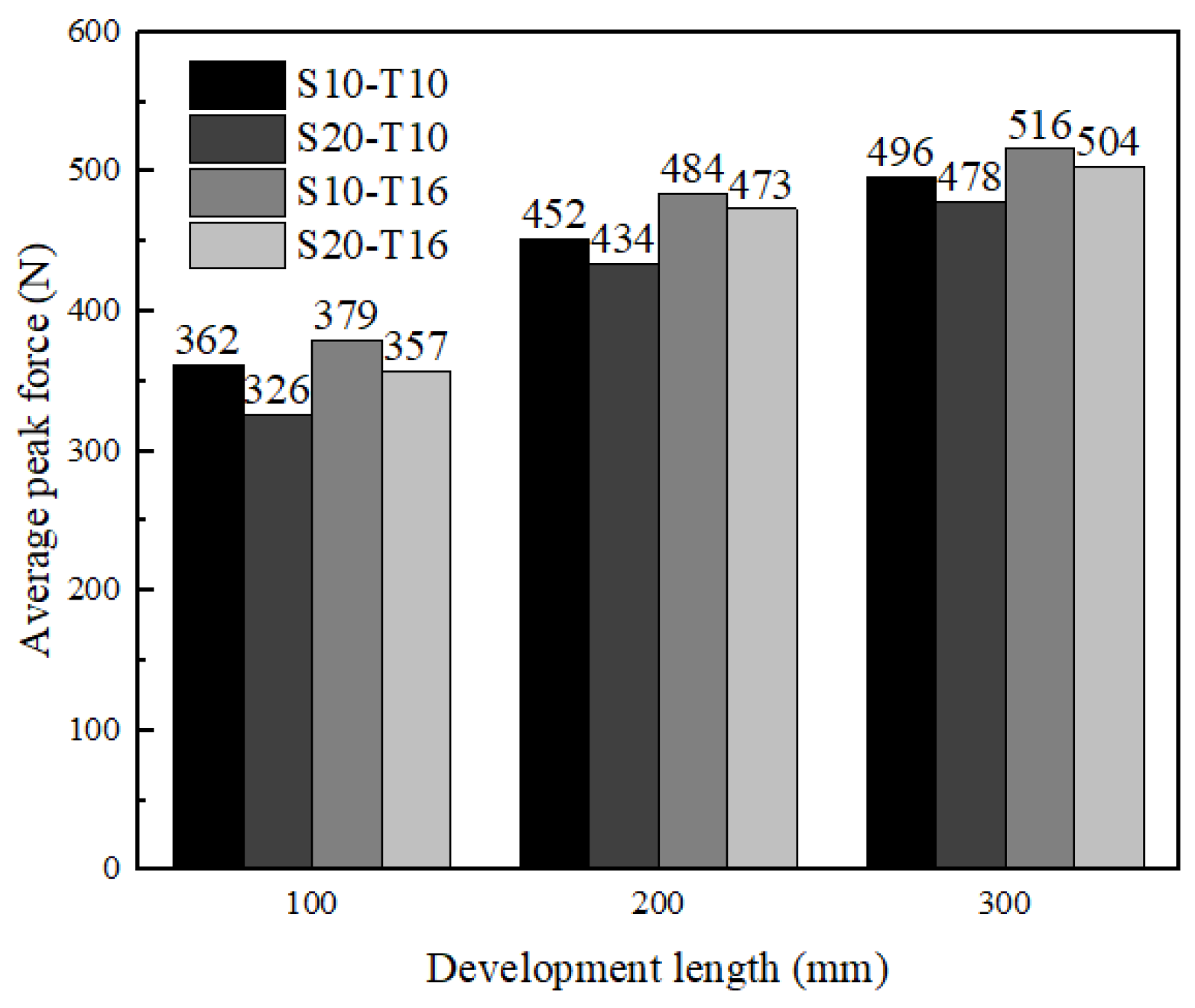
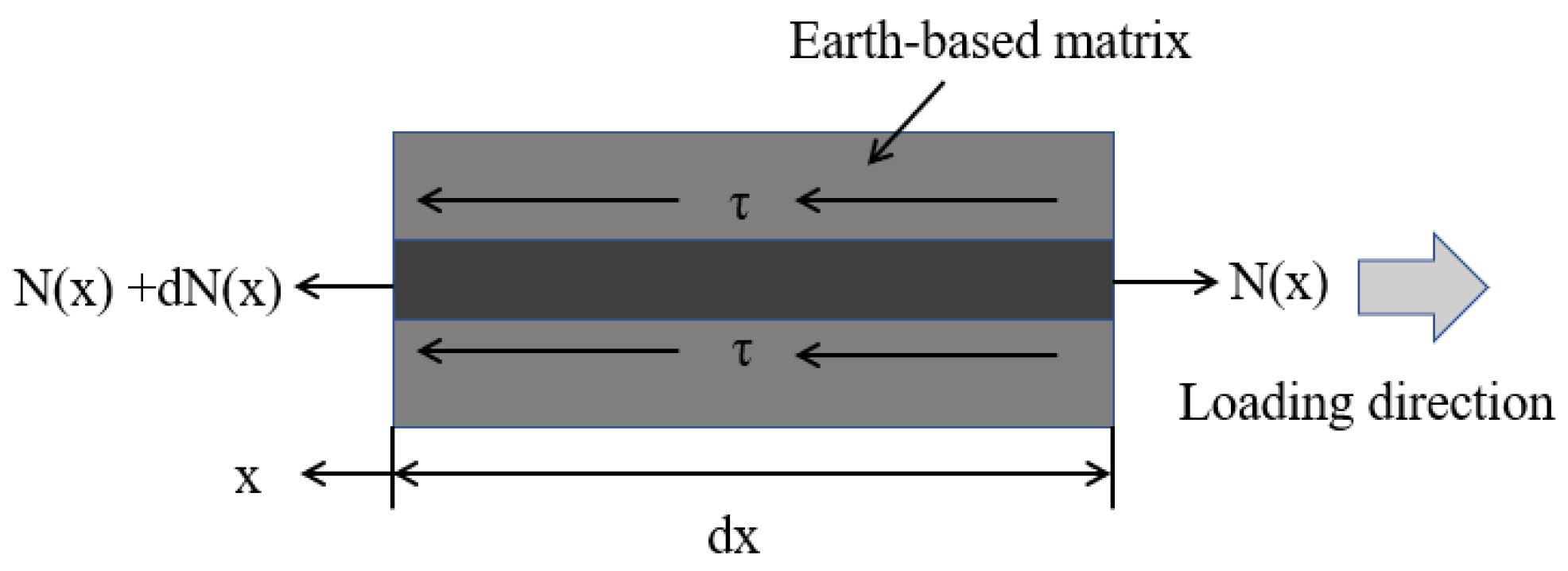
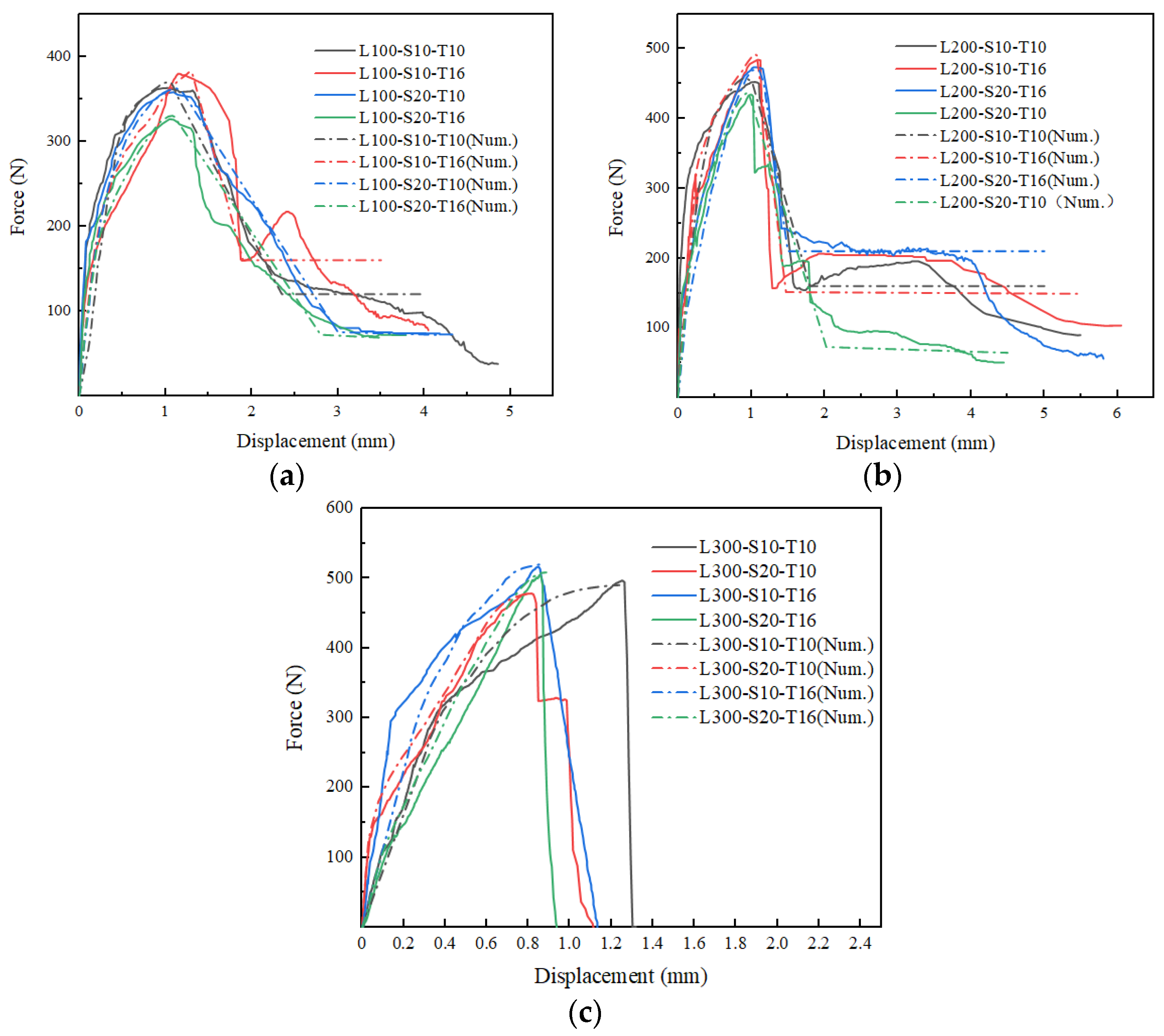
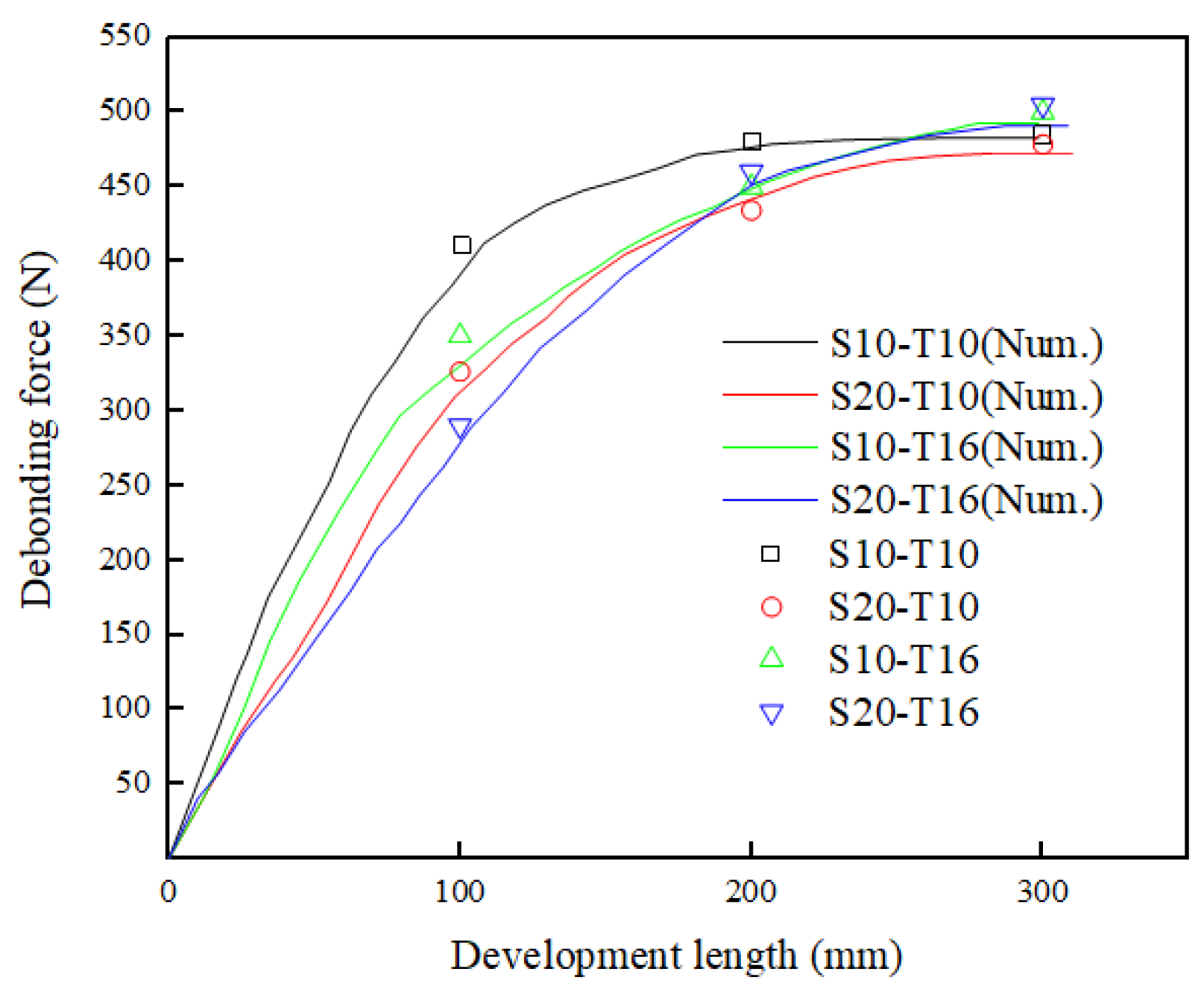
| Materials | Area of Warp Yarn (mm2) | Surface Mass Density (g/m2) | Strength (MPa) | Ultimate Strain (%) | Elastic Modulus (MPa) |
|---|---|---|---|---|---|
| Earth-based matrix | - | - | 5.6 (3.35%) | 3.07 (6.31%) | 132.5 (6.74%) |
| Glass textile mesh | 0.38 | 159 | 501.43 (5.12%) | 3.62 (6.43%) | 13,862 (3.53%) |
| ID | Failure Mode | Peak Force(N) | Strain at Peak Force (%) |
|---|---|---|---|
| L100-S10-T10-1 | Pulling out | 342.986 | 1.245 |
| L100-S10-T10-2 | Pulling out | 368.940 | 0.974 |
| L100-S10-T10-3 | Compound mode | 376.321 | 0.865 |
| L200-S10-T10-1 | Compound mode | 463.547 | 1.137 |
| L200-S10-T10-2 | Pulling out | 441.136 | 0.988 |
| L200-S10-T10-3 | Compound mode | 452.628 | 1.043 |
| L300-S10-T10-1 | Textile rupture | 487.365 | 1.188 |
| L300-S10-T10-2 | Textile rupture | 492.463 | 1.323 |
| L300-S10-T10-3 | Textile rupture | 510.827 | 1.242 |
| L100-S20-T10-1 | Pulling out | 308.495 | 1.135 |
| L100-S20-T10-2 | Compound mode | 341.607 | 1.077 |
| L100-S20-T10-3 | Pulling out | 328.276 | 0.932 |
| L200-S20-T10-1 | Compound mode | 453.142 | 0.912 |
| L200-S20-T10-2 | Pulling out | 427.609 | 1.065 |
| L200-S20-T10-3 | Pulling out | 421.903 | 1.017 |
| L300-S20-T10-1 | Textile rupture | 471.582 | 0.953 |
| L300-S20-T10-2 | Textile rupture | 466.365 | 0.784 |
| L300-S20-T10-3 | Textile rupture | 497.148 | 0.708 |
| L100-S10-T16-1 | Compound mode | 366.852 | 1.037 |
| L100-S10-T16-2 | Compound mode | 396.473 | 1.178 |
| L100-S10-T16-3 | Pulling out | 375.391 | 1.223 |
| L200-S10-T16-1 | Compound mode | 496.502 | 1.065 |
| L200-S10-T16-2 | Compound mode | 477.346 | 1.109 |
| L200-S10-T16-3 | Compound mode | 479.157 | 1.093 |
| L300-S10-T16-1 | Textile rupture | 533.864 | 0.769 |
| L300-S10-T16-2 | Textile rupture | 492.451 | 0.966 |
| L300-S10-T16-3 | Textile rupture | 523.704 | 0.806 |
| L100-S20-T16-1 | Pulling out | 341.742 | 1.137 |
| L100-S20-T16-2 | Compound mode | 370.813 | 1.026 |
| L100-S20-T16-3 | Pulling out | 361.031 | 1.119 |
| L200-S20-T16-1 | Compound mode | 468.537 | 0.936 |
| L200-S20-T16-2 | Compound mode | 491.365 | 1.132 |
| L200-S20-T16-3 | Compound mode | 461.033 | 1.157 |
| L300-S20-T16-1 | Textile rupture | 508.469 | 0.824 |
| L300-S20-T16-2 | Textile rupture | 482.764 | 0.963 |
| L300-S20-T16-3 | Textile rupture | 523.113 | 0.784 |
| ID | ||||
|---|---|---|---|---|
| L100-S10-T10 | 0.302 | 1.028 | 0.058 | 3.813 |
| L200-S10-T10 | 0.188 | 1.056 | 0.054 | 3.526 |
| L300-S10-T10 | 0.165 | 1.251 | - | - |
| L100-S20-T10 | 0.181 | 1.048 | 0.054 | 3.249 |
| L200-S20-T10 | 0.120 | 0.998 | 0.023 | 2.014 |
| L300-S20-T10 | 0.113 | 0.815 | - | - |
| L100-S10-T16 | 0.316 | 1.146 | 0.073 | 3.163 |
| L200-S10-T16 | 0.208 | 1.089 | 0.061 | 1.475 |
| L300-S10-T16 | 0.169 | 0.842 | - | - |
| L100-S20-T16 | 0.198 | 1.094 | 0.038 | 2.577 |
| L200-S20-T16 | 0.131 | 1.075 | 0.018 | 3.716 |
| L300-S20-T16 | 0.125 | 0.857 | - | - |
Disclaimer/Publisher’s Note: The statements, opinions and data contained in all publications are solely those of the individual author(s) and contributor(s) and not of MDPI and/or the editor(s). MDPI and/or the editor(s) disclaim responsibility for any injury to people or property resulting from any ideas, methods, instructions or products referred to in the content. |
© 2023 by the authors. Licensee MDPI, Basel, Switzerland. This article is an open access article distributed under the terms and conditions of the Creative Commons Attribution (CC BY) license (https://creativecommons.org/licenses/by/4.0/).
Share and Cite
Han, W.; Wu, F.; Zhao, Y.; Wang, H.; Chu, S. Experimental Study on Bond Behavior of Glass Textile Mesh in Earth-Based Matrix. Materials 2023, 16, 1161. https://doi.org/10.3390/ma16031161
Han W, Wu F, Zhao Y, Wang H, Chu S. Experimental Study on Bond Behavior of Glass Textile Mesh in Earth-Based Matrix. Materials. 2023; 16(3):1161. https://doi.org/10.3390/ma16031161
Chicago/Turabian StyleHan, Weinan, Feng Wu, Yugang Zhao, Haitao Wang, and Shenglin Chu. 2023. "Experimental Study on Bond Behavior of Glass Textile Mesh in Earth-Based Matrix" Materials 16, no. 3: 1161. https://doi.org/10.3390/ma16031161
APA StyleHan, W., Wu, F., Zhao, Y., Wang, H., & Chu, S. (2023). Experimental Study on Bond Behavior of Glass Textile Mesh in Earth-Based Matrix. Materials, 16(3), 1161. https://doi.org/10.3390/ma16031161








